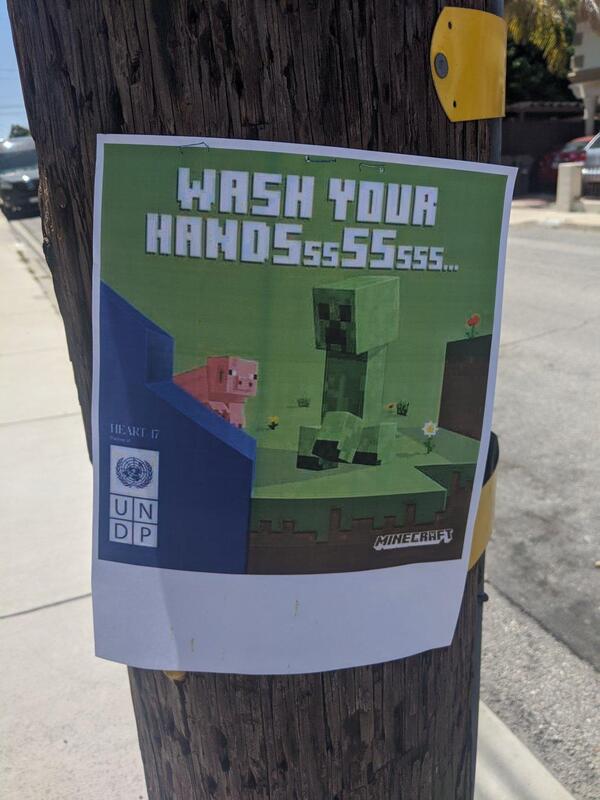
Kiddo found this image somewhere and wanted to put up a few signs.

Kiddo found this image somewhere and wanted to put up a few signs.
I’ve got to appreciate this network error UI from Minecraft Earth. Especially the button text.
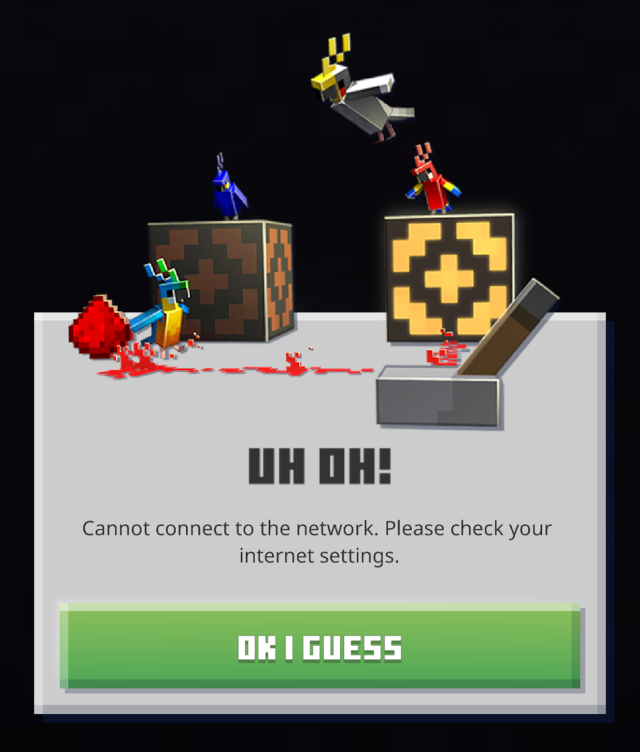
Took Minecraft Earth for a spin around the block. Most of the demos I’d seen showed either the build-on-a-plate mode or the AR adventure mode, so I wasn’t sure how the map mode was going to work.
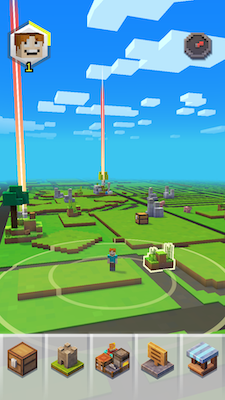 You see a Minecraft-ified version of your local area. Real-world buildings appear as raised ground instead of buildings, so that you can see where they are, but there’s no risk of mismatches between real doors and virtual ones. Clusters of resources appear on the map: trees, boulders, mounds of dirt and such, along with sheep, cows and other mobs wandering around. You can tap on them repeatedly like you’re mining in the original game, and after a few seconds you get the mob, or the logs, stone blocks, dirt, flowers, etc.
You see a Minecraft-ified version of your local area. Real-world buildings appear as raised ground instead of buildings, so that you can see where they are, but there’s no risk of mismatches between real doors and virtual ones. Clusters of resources appear on the map: trees, boulders, mounds of dirt and such, along with sheep, cows and other mobs wandering around. You can tap on them repeatedly like you’re mining in the original game, and after a few seconds you get the mob, or the logs, stone blocks, dirt, flowers, etc.
You can use these resources to craft items with familiar recipes, but each item takes time (like smelting) instead of a shape. It might take 30 seconds to turn a log into planks, or three minutes to make a sword. There are three slots for the crafting table and three for the furnace, with one each unlocked at the beginning of gameplay. I’m guessing you unlock the others as you level up.
Resources seem to regenerate quickly – I saw them pop into existence a couple of times on my walk around the block, and there was already a new tree when I got back where I started.
You can also see a circle (I know, a circle! In Minecraft!) on the map showing what’s close enough to interact with, and whenever something crosses that circle, the phone will vibrate briefly to let you know.
A nice touch: If you’re moving faster than walking speed (or if it thinks you are due to GPS drift), it shows your avatar rolling in a mine cart!
Speaking of avatars, if you’ve used the new character creator in recent releases of Bedrock edition, that skin automatically transfers to this game.
Actually playing “adventures” is a bit weird. This is the gameplay they showed during Minecon. At certain spots, you can jump into an augmented-reality instance (the one I tried was roughly a 5 block by 5 block column) with items you’ve crafted or collected. You can fight zombies, find treasure chests, etc. It’s cool, but because you can’t physically move up or down, just around, it’s sort of like walking around a hole in the ground and trying to interact with stuff that’s way below you.
Anyway, I’ve spent longer writing about it than playing so far. I’ll have to take some time to really explore it and get a better sense of the gameplay. And try out the build plates.
But even at first glance, it’s a distinct experience compared to Pokemon Go, and not just a rehash with a different theme!
Update: A key difference I’ve noticed between Pokemon Go and a couple of short sessions in Minecraft Earth is that the world of Minecraft Earth is a lot denser than Pokemon Go.
With Pokemon Go, you have fixed locations for supplies and combat. It’s all about getting you out to walk that distance and find Pokemon along the way. There are even multiple rewards solely for distance walked (candy, hatching eggs, evolving certain Pokemon).
With Minecraft Earth, everything is randomly placed, closer together, and visible from farther away: resources, mobs, adventures. (And you can use a build plate anywhere.) It looks more like a Minecraft world than a map, and it feels like you could play it in a smaller space if you wanted to.
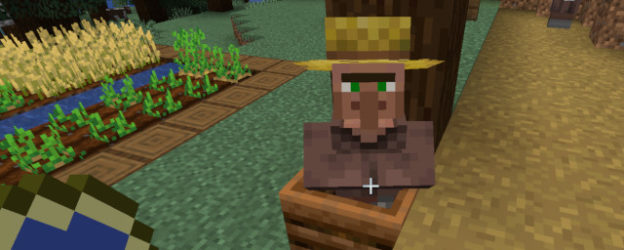
The latest Minecraft update, “Village and Pillage,” has completely revamped villager professions and trading, and made major changes to the village structures as well. Each profession now has a work site defined by a block like a stone cutter, or a loom, or a composter, etc. and unemployed villagers will try to fill jobs based on what’s available.
Now, Minecraft has always been (in my experience, anyway) pretty good about upgrading existing worlds as the game engine changes.
Normally this works great! But can you see the problem with villages?
Yeah. The villagers operate on the new rules, which means they need work sites to do their jobs, but the existing villages were built without any workstations.
So the village near my current base suffered an economic collapse, or perhaps an attack of existential mass ennui, leaving every villager unemployed.
Fortunately, all the new workstations are craftable. Even the ones that the player can’t use yet. So I spent some time on the wiki, writing down the ingredients I needed, went back to my base, crafted all of the ones I could, and started placing them around the village.
And it worked! Pretty soon I was able to trade with a farmer, librarian, fisherman, butcher, cartographer, etc. I’m still waiting for some of the unemployed villagers to pick up jobs. Maybe they need to actually walk close enough to the job sites or something?
Anyway, here’s the list of ingredients I put together based on the wiki article on villagers. You can get the crafting recipes from the wiki or in the game from the recipe book:
Minecraft Villager Job sites
| Job Site Block | Profession | Ingredients |
|---|---|---|
| Blast furnace | Armorer | 5 iron ingots, 1 furnace, 3 smooth stone |
| Smoker | Butcher | 4 logs, 1 furnace |
| Cartography Table | Cartographer | 2 paper, 4 planks |
| Brewing Stand | Cleric | 1 blaze rod, 3 cobblestone |
| Composter | Farmer | 4 fences, 3 planks (Java) or 7 planks (Bedrock) |
| Barrel | Fisherman | 2 wooden slabs, 6 planks (Java) or 2 wooden slabs, 6 sticks (Bedrock) |
| Fletching Table | Fletcher | 2 Flint, 4 planks |
| Cauldron | Leatherworker | 7 iron ingots |
| Lectern | Librarian | 4 wooden slabs, 1 bookshelf |
| Stonecutter | Mason | 1 iron ingot, 3 stone |
| Loom | Shepherd | 2 string, 2 planks |
| Smithing Table | Toolsmith | 2 iron ingots, 4 planks |
| Grindstone | Weaponsmith | 1 stick, 1 stone slab, 2 planks |
(Yes, a few of these are actually different in Bedrock Edition and Java Edition! I don’t know why Mojang would deliberately introduce differences in something as basic as crafting recipes, but apparently they have.)
Depending on how you play the game, you may never need to do this. If you generate new worlds all the time, or if you’re happy to just pull up stakes and move to a new area in the same world, you’ll encounter the updated villages to start with. But if you play like I do – explore the same world slowly, digging in, building up and establishing bases as I go – you’ll be glad to know that this works to manually upgrade your villages.
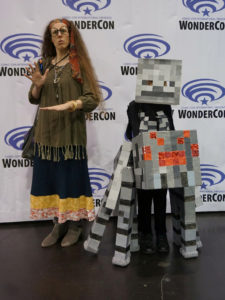 For this year’s WonderCon, Katie refined her Professor Trelawney costume from Long Beach. The biggest change: extending the skirt instead of using actual layers, because it was warm in Anaheim. Just for the weekend – it jumped about 10°F just before and was expected to drop 10°F afterward. She remarked, only half-jokingly, that if she’d tried to do Whitney Frost, the makeup would have melted.
For this year’s WonderCon, Katie refined her Professor Trelawney costume from Long Beach. The biggest change: extending the skirt instead of using actual layers, because it was warm in Anaheim. Just for the weekend – it jumped about 10°F just before and was expected to drop 10°F afterward. She remarked, only half-jokingly, that if she’d tried to do Whitney Frost, the makeup would have melted.
The great thing about Trelawney: Not only is she instantly recognizable to almost anyone (though she did get mistaken for Dr. Olivia Octavius at one point), but there were a lot of Harry Potter cosplayers at the con! Every time she ran into an Umbridge, she’d pretend to hide.
 For Sunday, she reassembled her Yomiko Readman (a.k.a. The Paper from Read or Die) costume from a few years back. Weirdly enough, more people seemed to recognize her than used to when she wore it in San Diego!
For Sunday, she reassembled her Yomiko Readman (a.k.a. The Paper from Read or Die) costume from a few years back. Weirdly enough, more people seemed to recognize her than used to when she wore it in San Diego!
The kiddo wanted to wear the Minecraft Spider Jockey costume again, and it was just as big a hit this year as last time. And even though the straps left his shoulders sore (Katie plans to redo them with actual backpack straps), he wanted to keep it for the second day. Unfortunately that was a bit too much, and we ended up leaving early Sunday afternoon.
For more photos of all three costumes, and a bunch of other cosplayers we ran into at the con, check out the full gallery on Flickr.